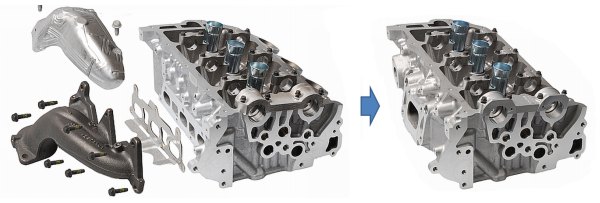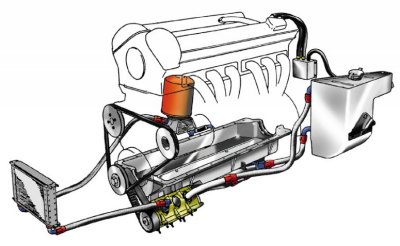|
AUTOZINE TECHNICAL SCHOOL
Engine Construction and Materials Cylinder head
While most production engines turned to aluminum blocks not too long ago, aluminum cylinder heads have been the norm for many decades. Cylinder head is the hottest part of the engine since compression and combustion take place underneath it. To avoid knocking, it is crucial to keep cylinder head cool. As aluminum has good thermal conductivity, it is naturally the material choice for cylinder head, especially for high-performance engines. The aluminum alloy normally includes silicon and magnesium to achieve the required strength and corrosion resistance. Sometimes copper and nickel are added to improve heat resistance. Cylinder head is generally made of conventional die casting. Some very exotic engines, especially for motorsport purposes, employ CNC machine to shape their combustion chambers, intake and exhaust ports more precisely in order to optimise combustion and air flow. Examples include Aston Martin V12s, Ford Mustang Boss 302 and Chevrolet Camaro Z/28. Pistons, connecting rods and crankshaft are reciprocating mass. The lighter they are, the faster the engine revs and the more power is produced. Like cylinder head, car makers have been using aluminum alloy to make pistons for many decades. Normally the piston is casted, but high-end performance cars usually employ forged pistons. Forging is a manufacturing process that heats up the aluminum alloy to about 430°C and then punch it into a die with very high pressure. Forged pistons have finer, denser microstructure thus are stronger and more resistant to heat. This means the pistons can be made thinner and lighter to enhance rev. Likewise, performance-oriented connecting rods are also made by forging, but they are made of chrome-moly steel instead because aluminum is not strong enough for the job. Very high-revving engines, such as those of Porsche 991 GT3 and Ferrari 458 (both were capable to rev to 9000 rpm) use even titanium connecting rods, which are a third lighter but cost a lot more. Titanium con-rod was first introduced to the 1990 Honda NSX. Ferrari followed in 1994 on its F355 and kept using it on every generation of its V8 models until 488GTB, which switched to turbocharging thus no longer chased for rev. More recently, Lamborghini is developing carbon-fiber connecting rods. They are made of a forged composite which consists of a mix of carbon fiber and resin, heated and pressurized in a mold. The rods are 40-50% lighter than steel ones. Expect them to arrive on the next generation Aventador in about 2020. Crankshaft on performance engines are normally made of forged chrome-moly steel. There are still no better alternatives. Billet crankshaft, which is carved from a solid block of steel using CNC machine, is even stronger, but so far its applications are limited to motorracing and aftermarket because of extreme costs. Camshaft, Valvetrain and Valve
Camshaft is normally made of steel. Hollow camshaft is increasingly popular on production cars as means of reducing weight. To reduce frictional loss from the valvetrain, many engines use roller finger followers, or more recently, apply diamond-like carbon (DLC) coating to the finger followers and tappets. DLC is hard, wear-resistant and slick. Valves are the hottest part of the engine, especially exhaust valves, which can reach more than 800°C, so the material must be heat-resisting. The standard choice is stainless steel, but high-performance engines may need Inconel (a nickel-chromium alloy) or ultimately titanium, which is 40% lighter than steel valves. It goes without saying less inertia allows the engine to rev higher. Engines using titanium valves include Toyota Altezza's 2.0, Infiniti 4.5 V8, Lexus 5.0 V8 and various GM small-block V8 (e.g. LS7, LS9, LSA and LT4). The GM small-blocks had unusually large intake valves (since they had only 2 valves per cylinder), thus needed titanium to cut inertia. To deal with high temperature, some performance engines employ sodium-filled exhaust valves. The valve stem is hollow and partially filled with liquid sodium, which is a good heat conductor. When the valve moves up and down, the liquid sodium moves back and forth between the lower end and upper end, transferring heat from the valve seat to the coolant at the cylinder head. This can drop the exhaust valve temperature by up to 150°C, lifting knock resistance thus allowing the compression ratio to be increased. Intake and Exhaust Manifold
Intake manifold is not subjected to very high temperature thus there is a wide variety of material choices:
At the exotic end, Inconel manifold is popular. Inconel is an alloy made of nickel and chromium, very heat resisting yet lighter than stainless steel.  Conventional exhaust manifold (left) vs Integrated exhaust manifold (right) Integrated Exhaust Manifold: conventionally, exhaust manifold is made separately and bolted to the cylinder head through gasket, and there is usually a heat shield mounted outside. In recent years, many engines have turned to integrated exhaust manifold, which has the exhaust manifold casted into the cylinder head to form a single unit. This saves weight, space, cost and improves cold start emission. It is becoming the industrial norm.
Sump Sump (or oil pan) is the part located at the bottom of the engine to collect lubrication oil for recirculation. Most production cars use "wet sump", but high-performance cars and racing cars employ "dry sump" lubrication. A wet sump is quite large and deep because it needs to contain all oil. In contrast, a dry sump is a lot shallower because most of the oil is stored at a separate oil reservoir located outside the engine. A scavenging pump in the sump pumps the oil into the reservoir, then another pump transfers the oil to the moving parts that need lubrication. As a result, a dry-sump engine can sit closer to the ground and lower center of gravity significantly. Moreover, as the oil reservoir is much deeper than wet sump, the lubrication keeps working properly at high cornering g-force. Both explain why it is a must for motorracing.
Sump can be made of pressed steel, cast aluminum or magnesium, depending on applications. In recent years, BMW and Volkswagen tried plastic sump on their N20 and EA888 engines respectively. |
||||
| Copyright© 1997-2017 by Mark Wan @ AutoZine |
